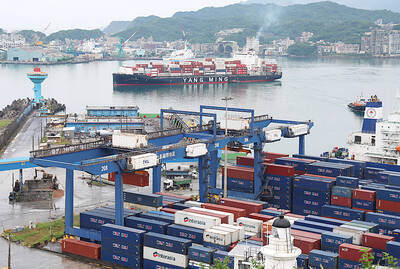Wind ruffling his hair, Jeffrey Lee unlocks the gate of a bamboo fence surrounding two gigantic windmills, reads the meter and smiles.
Wind speed is good and enough electricity is being generated by the turbines to power Cheng Loong Corporation's (正隆公司) paper mill in the remote coastal area of Chupei, northern Taiwan.
The 93m high, Denmark-designed windmills have generated about 20 million watts of electricity for the mill's use over the past two years, worth some NT$36 million (US$1.07 million).
They have also become an unlikely popular tourist attraction.
"The two white wind turbines have become a new landmark of Hsinchu county," Lee, a 46-year-old engineer, says proudly. "Taiwan's west coast will feature hundreds of windmills a few years from now."
Taiwan imports nearly all of its energy needs and projects like this are part of a nationwide effort to generate electricity from renewable sources, including hydraulic, wind and solar power.
It should account for 10 percent of domestic supply by 2011, up from the present 5.45 percent, with wind-power totaling more than 2,000 megawatts, equivalent to the amount needed to power 4.75 million homes for a year.
Like Asian neighbors such as China and the Philippines, Taiwan has awakened to the need for sustainable energy production, a need made more acute by recent spikes in global oil prices.
In 2000 the ruling Democratic Progressive Party in 2000 decided to help fund investment in renewable energy in response to calls from conservation groups.
Cheng Loong executives inaugurated the Chupei turbines, which have a combined capacity of 3.5 megawatts, in late 2002 at a cost of NT$115 million (US$3.43 million), with NT$50 million being subsidized by the government.
They have been impressed by the revenues, but when the company, which reported NT$1.1 billion in net profit on revenues of NT$20.04 billion last year, recently looked to expand its wind power operations they found several others were one step ahead.
Cheng Loong's competitors had applied with the government for the acquisition of land on which hundreds of turbines will be built to create wind farms along the north and west coast of the island.
State-run Taiwan Power Co (台電), which provides most of the nation's electricity, currently has 40 wind turbines with a total of almost 48 megawatts' capacity, and is planning to build another 147 wind turbines on Taiwan and the island of Penghu in the Taiwan Strait before the end of 2010. Each turbine costs at least NT$100 million.
Another major company setting sight on the island's wind power industry is Germany-based InfraVest WindPower, which plans to build wind turbines with at least 300 megawatts of capacity, says David Chang, the company's senior electrical manager.
Twenty-five InfraVest wind turbines in the central county of Miaoli, each with a capacity of 2.0 megawatts, are due to become operational before the year's end, he says, adding that up to 70 others located near that area are scheduled to come on stream next year.
Chen Wu-hsiung, head of Taipower's Wind Power Construction Institute, says that despite the rush, producing renewable energy is "no easy task."
Industry experts complain of low electricity prices, preventing a worthwhile return on investment.
"Some companies have displayed interest in investing in the wind power sector, but the government has not come up with strong incentives to woo the potential investors," Cheng Loong's Lee says.
"It would take private investors some 10 years to get back their money. That's a bit too long," InfraVest's Chang says.
Taipower last raised electricity prices 22 years ago. Despite soaring coal, oil and natural gas prices, the company has repeatedly been ordered to cut power prices to help the government stabilize domestic consumer prices.
As a result, the company in 2005 may suffer a deficit of NT$6.1 billion (US$183.18 million) -- the first loss since the company was established 59 years ago -- according to a budget approved by parliament.
"That would put Taipower in an unfavorable position to raise funds from the capital market both here and abroad to continue with its investment projects," a Taipower spokesman says.
Taipower plans to build 546 offshore wind turbines, each with a capacity of 3.6 megawatts from 2010-2020. Each of those turbines will cost an estimated NT$200 million. Out of the 546, 176 would be built off Penghu, which Chen says is one of the best located wind farms in the world. Electricity would be transmitted to Taiwan through 40km undersea cables.
The rest of the planned offshore turbines would be located some 10-15 kilometers off the western counties of Changhwa and Yunlin.
Domestic consumption of power has risen at an average 4.5 percent a year over the past few years and Taiwan's energy companies have been exploring other alternative energy sources, like hydraulic and solar power.
"As hydraulic power is nearly saturated on Taiwan after decades of development and solar power is not really commercially viable, wind power has the most potential as a source of clean energy for the coming decade," Taipower's Chen says.
Taipower's hydraulic power plants have a combined capacity of 1,868 megawatts, just over five percent of the island's usage, while it also operates three nuclear power plants and is building a fourth, the last that will be permitted in Taiwan under an accord between the main political parties.

CHIP RACE: Three years of overbroad export controls drove foreign competitors to pursue their own AI chips, and ‘cost US taxpayers billions of dollars,’ Nvidia said China has figured out the US strategy for allowing it to buy Nvidia Corp’s H200s and is rejecting the artificial intelligence (AI) chip in favor of domestically developed semiconductors, White House AI adviser David Sacks said, citing news reports. US President Donald Trump on Monday said that he would allow shipments of Nvidia’s H200 chips to China, part of an administration effort backed by Sacks to challenge Chinese tech champions such as Huawei Technologies Co (華為) by bringing US competition to their home market. On Friday, Sacks signaled that he was uncertain about whether that approach would work. “They’re rejecting our chips,” Sacks

Taiwan’s exports soared 56 percent year-on-year to an all-time high of US$64.05 billion last month, propelled by surging global demand for artificial intelligence (AI), high-performance computing and cloud service infrastructure, the Ministry of Finance said yesterday. Department of Statistics Director-General Beatrice Tsai (蔡美娜) called the figure an unexpected upside surprise, citing a wave of technology orders from overseas customers alongside the usual year-end shopping season for technology products. Growth is likely to remain strong this month, she said, projecting a 40 percent to 45 percent expansion on an annual basis. The outperformance could prompt the Directorate-General of Budget, Accounting and

BARRIERS: Gudeng’s chairman said it was unlikely that the US could replicate Taiwan’s science parks in Arizona, given its strict immigration policies and cultural differences Gudeng Precision Industrial Co (家登), which supplies wafer pods to the world’s major semiconductor firms, yesterday said it is in no rush to set up production in the US due to high costs. The company supplies its customers through a warehouse in Arizona jointly operated by TSS Holdings Ltd (德鑫控股), a joint holding of Gudeng and 17 Taiwanese firms in the semiconductor supply chain, including specialty plastic compounds producer Nytex Composites Co (耐特) and automated material handling system supplier Symtek Automation Asia Co (迅得). While the company has long been exploring the feasibility of setting up production in the US to address

OPTION: Uber said it could provide higher pay for batch trips, if incentives for batching is not removed entirely, as the latter would force it to pass on the costs to consumers Uber Technologies Inc yesterday warned that proposed restrictions on batching orders and minimum wages could prompt a NT$20 delivery fee increase in Taiwan, as lower efficiency would drive up costs. Uber CEO Dara Khosrowshahi made the remarks yesterday during his visit to Taiwan. He is on a multileg trip to the region, which includes stops in South Korea and Japan. His visit coincided the release last month of the Ministry of Labor’s draft bill on the delivery sector, which aims to safeguard delivery workers’ rights and improve their welfare. The ministry set the minimum pay for local food delivery drivers at